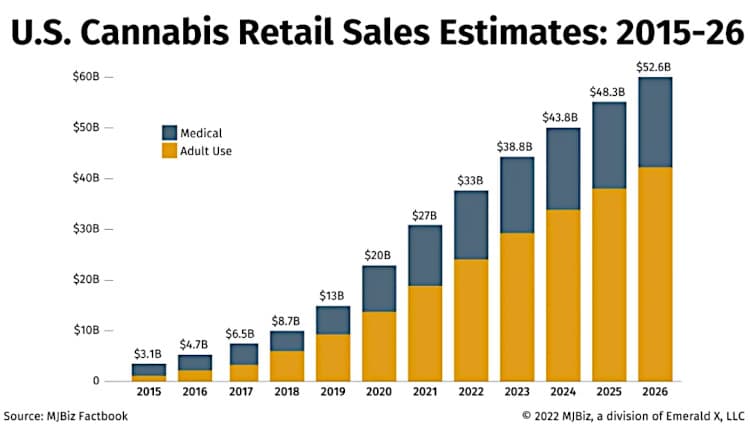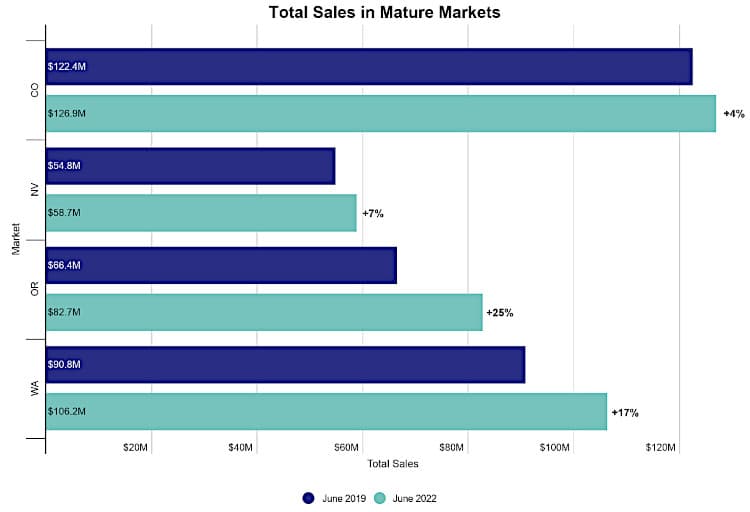Contradictions are rife in the societies that surround us. America is one of two countries in the world where pharmaceutical companies can peddle drugs directly to consumers, but if you smoke a plant that grows like a weed, you’ll get put in the slammer in some states. So why has it taken so long for America to start legalizing a plant that’s benign when compared to Class A drugs like Adderall that are handed out like candy?
Pending legalization is one reason why we waited so long before investing in cannabis stocks. There’s been a lot of noise surrounding the great green rush. Only after years of watching and analyzing the industry – and partaking of its now somewhat legal products around the world for extensive market research – did we finally pull the trigger on one cannabis stock. We recently revisited Trulieve Cannabis Corp (TCNNF), which we believe is one of the best of many multi-state operators (MSOs) out there that run vertically integrated retail operations, despite some flaws. However, it’s not the biggest cannabis company based on market cap.

Canopy Growth Corporation (CGC) and Tilray (TLRY) primarily earn money through cannabis production (aka, growing weed). The former used to be the largest cannabis company in the world, while the latter is an unwieldy weed conglomerate that we had no interest in as investors. Like Trulieve, Curaleaf (CURLF) and Green Thumb Industries (GTBIF) are leading MSOs that trade on the Canadian Securities Exchange (CSE), sometimes known as the Cannabis Securities Exchange because pot companies dominate the listings. A year ago, we did a head-to-head analysis between those two companies to determine which offered better value to investors. Green Thumb Industries (GTI) stock was the clear winner, so let’s see what’s been happening over the last 12 months.
The Cannabis Market Today
Before we go there, let’s briefly check in with where the cannabis market is today. It’s been a decade since Colorado became the first U.S. state to welcome recreational sales. Since then, 20 other states have legalized it, with Maryland and Missouri joining the list in 2022 (but three others voting it down). Nearly 80% of the country also has medical marijuana laws on the books. Both Mexico and Canada have legalized weed at the national level, along with the first country in the world to do so – Uruguay.
But let’s focus on the United States, which presumably hosts the largest potential market based on population and consumption, despite the fact that different Google search results will turn up Israel, Iceland, Chile, or Nigeria, as the most stoned country per capita. U.S. retail sales are projected to reach more than $50 billion by 2026, according to the stoners analysts at MJBiz Factbook.

Recent headlines, however, would suggest that the market is softening. MJBizDaily recently declared the boom times were over for Colorado, where wholesale flower prices dropped to an all-time low last year. It took Massachusetts only half the time to reach a similar saturation point. A bumper harvest late last year certainly didn’t help the situation. Again, we can’t get caught up in the noise blaring at us in the moment, but need to look at the long-term trends. While many thought the Rona would be the new normal – with ridiculously high expectations for pandemic darlings like Zoom – it just turned up the noise volume to 11.
A report from cannabis data firm Headset that looked at the most mature markets in the United States makes the point. Using point-of-sale data from retailers, it showed that sales slumped in the latter part of 2022 compared to the first 18 months of the pandemic, when many people were day drinking and hitting the bong before breakfast. Remove the noise, and the long-term trend is still steady growth. For example, despite experiencing a 20% decline in monthly sales over the past year, Oregon is still up 25% over the past three years.

It’s called market correction, which is what we’ve been witnessing with tech stocks. In addition, a number of new cannabis markets are opening up this year, as recently legalized states start approving retail licenses. While things remain stalled at the federal level, there’s no putting the genie back in the bottle. The cannabis market is only going higher.
Why We Like GTI Stock

Through that lens we can now evaluate GTI stock. In our original analysis, we liked it more than Curaleaf because it had achieved consistent profitability without taking on crushing debt. While we’re still awaiting full 2022 financial results, the numbers look pretty good. Year-to-date 2022 revenue increased 17% to $758 million compared to the first nine months of 2021, putting the company on course to break the $1 billion threshold. That would pretty much keep pace with the 18% overall cannabis market increase we introduced earlier from MJBiz Factbook. Revenue is split between the company’s 77 retail locations in 15 states and its line of consumer products like Dogwalkers pre-rolls, which are the perfect size for taking your pitbull for a walk. (Intersegment revenues refer to revenue within the company between GTI’s retail operations and consumer brands, so those aren’t counted.)

The company has also posted nine consecutive quarters of net revenue, which isn’t something we can say about some of the tech stocks in our portfolio.

However, you’ll note that net profit is dropping, coming in at just $10 million in Q3-2022. Overall, though, the company appears to be in good financial shape. It ended Q3-2022 with nearly $150 million in cash or something approximating cash, against about $255.5 million in debt. Gross profit was about 50%, which is pretty respectable for a retail business that also produces much of the product on its shelves.
Outlook for GTI Stock in 2023
We’re MBAs, not mystics with crystal balls, but we can take a look at the available data and make some educated guesses about where GTI is headed this year.
For starters, the cannabis company is pushing hard into Florida, which is reportedly the third largest cannabis market in the United States, with annualized sales of more than $2 billion, despite still being a medical-only market. (That’s where Trulieve has established a leadership position.) GTI announced last year it would co-locate 10 RISE Express branded medical dispensaries at Circle K stores in Florida. Indeed, strain things are afoot at the Circle K, though the company has yet to receive regulatory approval. Both New York and Rhode Island started recreational sales last month, and Connecticut should follow sometime this year. GTI already had operations in all three states, so it should be ready to compete.

There’s been a lot of buzz around plans by Canopy Growth Corporation to perform some creative restructuring in order to acquire U.S.-based businesses that management says will ultimately move it toward profitability. CGC shares are traded on both the Nasdaq and CSE. The Toronto Stock Exchange (TSE), the third largest in North America, has reportedly given the green light to the plan, which would allow CGC to uplist on the TSE from the CSE. Got it so far? However, the Nasdaq has threatened to potentially delist CGC if it follows through with its plan to enter the U.S. cannabis market. Apparently, cannabis companies can list on U.S. exchanges if they operate in Canada, where weed is legal at the national level, but not in the United States, where Uncle Sam is still a square.
What does all of this have to do with GTI? There’s been speculation that other cannabis companies might follow CGC’s lead to get listed on the Toronto Stock Exchange. GTI management confirmed that it would not likely go that route, and is holding out for the bigger prize of listing on a major U.S. exchange. Currently, GTI shares are traded on CSE and over-the-counter, which is keeping most institutional investors on the sidelines and subsequently keeping share prices depressed. While we doubt the U.S. government is ready to legalize weed nationally this year, the new Congress did introduce its first cannabis-related law that would allow those who use it to possess firearms. That’s what we call progress in ‘Merica.
Conclusion
While we think it is high time to invest in cannabis, retail investors need to proceed with caution. The prevailing wisdom is that MSOs are a safer bet than companies primarily engaged in plant production, and the precipitous price drops on raw flower underscores that approach. That’s why companies like CGC are trying to diversify by acquiring MSOs like Acreage Holdings and other businesses not directly involved in the agricultural side of the equation. We’ve said before that retail investors interested in this highly risky theme could do themselves a favor by investing in several MSOs to cover the bases, and GTI stock is probably one of the best to own given the nature of the cannabis industry.
Tech investing is extremely risky. Minimize your risk with our stock research, investment tools, and portfolios, and find out which tech stocks you should avoid. Become a Nanalyze Premium member and find out today!



Be the first to comment